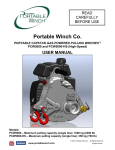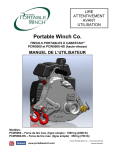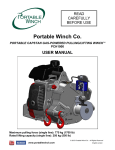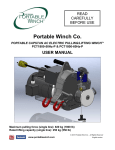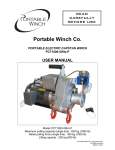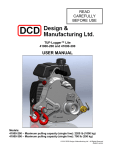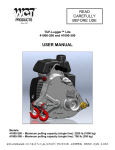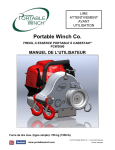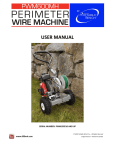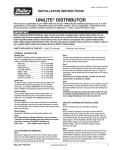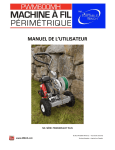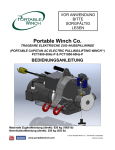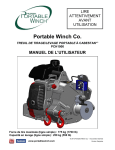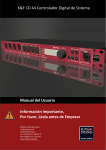Download Instruction Manual - Forestry Suppliers, Inc.
Transcript
READ CAREFULLY BEFORE USE Portable Winch Co. PORTABLE CAPSTAN WINCHTM PCW5000 USER MANUAL Model: PCW5000 Maximum pulling capacity (single line): 1000 kg (2200 lb) Summary Introduction – p. 3 1.0 Safety guidelines – p. 3 1.1 Safety messages – p. 3 1.2 Labels – p. 4 1.3 Safety information – p. 4 2.0 Before first use – p. 5 2.1 Upon receiving the winch – p. 5 2.2 Is the engine ready to work? – p. 5 2.2.1 Engine oil – p. 5 2.2.2 Gas – p. 5 2.2.3 Engine start-up – p. 6 2.2.4 Capstan drum – p. 6 2.2.5 Spark arrestor – p. 7 3.0 Winch usage – p. 8 3.1 Rope – p. 8 3.1.1 Rope type – p. 8 3.1.2 Rope maintenance – p. 9 3.2 At the end of the rope – p. 9 3.2.1 Recommended knots – p. 9 3.2.2 Recommended hooks – p. 10 3.3 Winch anchor – p. 10 3.3.1 Using a polyester sling – p. 11 3.3.2 Using the hitch plate winch anchor – p. 11 3.3.3 Using the receiver hitch winch anchor – p. 12 3.3.4 Using the tree/pole mount with anchor strap – p. 13 3.4 Oil AlertTM system – p. 13 3.5 Rope installation – p. 14 3.5.1 Rope – p. 14 3.5.2 Pulley – p. 14 3.5.3 Direction – p. 14 3.5.4 On a hill – p. 14 3.6 Pulling a load – p. 14 3.6.1 Wrapping the rope on the capstan drum – p. 15 3.6.2 Winching – p. 15 3.6.2.1 If the rope slips – p. 15 3.6.2.2 To ‘’rock’’ the load – p. 16 3.6.2.3 How to pause while winching – p. 16 3.6.2.4 How to maintain a load without releasing the tension – p. 16 3.6.2.5 How to resume winching – p. 16 3.6.2.6 If you must keep tension on the rope at start-up – p. 17 3.6.2.7 If your rope is too short – p. 17 3.6.3 Stopping the winch – p. 17 4.0 Maintenance – p. 17 4.1 Cleaning – p. 17 4.2 Lubrication – p. 18 4.3 Honda engine – p. 18 4.4 Storage – p. 18 4.5 Spark arrestor – p. 18 5.0 Complementary information – p. 18 5.1 Accessories – p. 18 5.2 Warranty – p. 20 5.3 Serial number localization – p. 20 5.4 CE Declaration of conformity – p. 21 5.5 Exploded view and parts list – p. 22 5.6 Technical data – p. 24 5.6.1 Noise emissions – p. 24 5.7 Manufacturer – p. 24 2 Introduction Portable Winch Co. wishes to thank you for purchasing a PCW5000 Portable Capstan WinchTM. This manual was written to help you make the best use of your new winch and to use it in the most secure way. Read it carefully before using the winch. For any problems or questions please refer to an authorized Portable Winch Co. dealer or contact us directly. 1.0 Safety guidelines The PCW5000 Portable Capstan WinchTM is designed to pull non-rolling objects, usually at a plus or minus 45 degree angle from the horizontal. The use of a pulling device implies serious risks of injuries, property damage or even death. Do not underestimate its potential danger. 1.1 Safety messages Your safety and the safety of others are very important. You will find important safety messages in this manual. Read them carefully. These security messages are warning you of potential injuries to either you or others. Every safety message is preceded by a warning symbol DANGER, ATTENTION or PRECAUTION. and one of the following terms: These indicator words mean: You WILL be MORTALLY or SEVERELY INJURED if you do not follow these instructions. You COULD be MORTALLY or SEVERELY INJURED if you do not follow these instructions. You COULD be INJURED if you do not follow these instructions. 3 1.2 Labels The warning and guaranteed sound power level labels are positioned on the right side of the winch housing. 1.3 Safety information Do not let children use the Portable Capstan WinchTM. Keep children and animals away from the work area. NEVER LET SOMEONE WITHOUT TRAINING USE THE PORTABLE CAPSTAN WINCHTM. MAKE SURE THE USER KNOWS ABOUT THE SAFETY AND USAGE PROCEDURES AND HAS READ THIS MANUAL AND THE HONDA ENGINE USER MANUAL. INFORM ALL USERS OF THE SAFETY GUIDELINES AND USAGE PROCEDURES. FAMILIARIZE YOURSELF WITH THE PRODUCT AND THE SAFETY GUIDELINES BEFORE WORKING WITH THE WINCH. 4 MAKE SURE THAT YOUR CLOTHES ARE NOT GOING TO GET CAUGHT INTO THE WINCH MOBILE PARTS. THE EXHAUST GAS CONTAINS TOXIC CARBON MONOXIDE. NEVER RUN THE ENGINE IN A CLOSED AREA WITHOUT PROPER VENTILATION. REPLACE ANY SAFETY LABELS THAT ARE DAMAGED, ILLEGIBLE OR MISSING. NEVER PUT YOUR HANDS ON THE CAPSTAN DRUM, NEAR THE ROPE GUIDE OR THE FRONT PULLEY WHEN THE ENGINE IS RUNNING. ALWAYS KEEP BYSTANDERS OUTSIDE THE WORKING AREA. NEVER PULL ROLLING OBJECTS THAT MIGHT ROLL OUT OF YOUR CONTROL. THE PORTABLE CAPSTAN WINCHTM IS NOT INTENDED FOR LIFTING PURPOSES. NEVER USE THE PORTABLE CAPSTAN WINCHTM TO LIFT PEOPLE. ALWAYS WEAR GLOVES. WE RECOMMEND WEARING HEARING PROTECTION. DO NOT TOUCH THE CAPSTAN DRUM IMMEDIATELY AFTER OPERATION AS IT WILL GET HOT AND BURN BARE SKIN. 2.0 Before first use 2.1 Upon receiving the winch Inspect the box to detect any apparent damage. If there is damage or missing parts, inform the carrier immediately. 2.2 Is the engine ready to work? 2.2.1 Engine oil Fill the Honda engine with a maximum of 0.25 liter of SAE 10W-30 API SJ oil. For special usage or conditions such as extreme weather, refer to page 7 of the Honda engine user manual. Check the oil level on a horizontal surface. The oil level should be up to the edge of the opening. 5 2.2.2 Gas Fill the gas tank with unleaded fuel. Do not use oil/fuel mixture; your Portable Capstan WinchTM is equipped with a 4-stroke engine. Refer to page 7 of the Honda engine user manual. 2.2.3 Engine start-up Refer to page 3 of the Honda engine user manual for start-up instructions. The engine on-off switch is located on the winch housing, to the left of the handle (figure 1 to the right). Make sure to pull on the recoil starter in the axis of the rope outlet (figure 1 below). If you pull vertically (figure 2), the friction of the rope on the plastic cover might damage the rope and/or the cover. First use: Let the engine run five (5) minutes at idle before first pull. 2.2.4 Capstan drum Your Portable Capstan WinchTM is equipped with a standard 57 mm (2-1/4") diameter capstan drum. If you are using the optional 85 mm (3-3/8") drum (PCA-1100 sold separately), follow these simple installation steps (figures 1, 2, 3, 4 & 5 can be found on the next page). All bolts require a 4 mm (5/32") hex wrench, included with your winch manual. 1) Remove the rope guide (figure 1); 2) Remove the bolt located at the end of the drum shaft (figure 2); 3) Remove the drum from the shaft (figure 3). If necessary, you may push it forward with two screwdrivers; 4) Replace it with the optional drum (figure 4). Make sure that the shaft key stays in place. Install bolt and washer; 5) Install the rope guide (included with the optional drum) using the two (2) bolts. 6 IMPORTANT: Make sure that the rope guide is not in contact with the capstan drum. 2.2.5 Spark arrestor In certain areas, it is forbidden to use a gas engine without a spark arrestor. Check local regulations. An optional spark arrestor is available from Portable Winch Co. and/or Honda Power Products dealers. Installation: 1) Insert the spark arrestor into the exhaust tube. Make sure the holes are aligned (figure 1 to the right); 2) Fasten lightly the metal screw provided with the appropriate screwdriver (figure 2 to the right). Refer to page 10 of the Honda engine user manual for the spark arrestor cleaning instructions. • • Portable Winch part number: PCA-1151 Honda part number: 350-2M7-801 7 3.0 Winch usage MOST WINCHING SITUATIONS PRESENT POTENTIAL DANGERS! 3.1 Rope STAY OUT OF THE WINCH LINE’S PATH. 3.1.1 Rope type Use only low stretch rope. We recommend using double-braided polyester rope with a minimum diameter of 10 mm (3/8''). Maximum rope diameter is 16 mm (5/8"). For most situations, we recommend using 12 or 13 mm (1/2'') double braid polyester rope. Please contact us for other rope types suitability. DO NOT USE 3-STRAND POLYPROPYLENE YELLOW ROPE! Polypropylene and polyethylene ropes are dangerous for winching because of their great elasticity and low melt point. Make sure the rope is not damaged and that it offers an adequate resistance to pull the load. STRETCH EQUALS DANGER! A stretched rope can recoil and cause serious burns as the rope leaves your hand. All ropes stretch: a longer one more than a shorter one. The more you pull, the more it stretches. A stretched rope can also move the load in an unpredictable or dangerous way. A stretched rope can recoil and bring your hand towards the winch causing severe injuries. NEVER WRAP THE ROPE AROUND YOUR HAND. ALWAYS WEAR GLOVES. 8 3.1.2 Rope maintenance VISUALLY INSPECT YOUR ROPE BEFORE EACH USAGE. IF IT SHOWS ANY SIGN OF DETERIORATION (CUT STRANDS, EXCESSIVE ABRASION) REPLACE IT. IF YOUR ROPE IS DIRTY, WASH IT. DIRTY ROPES DETERIORATE FASTER AND CAUSE PREMATURE WEAR ON PARTS WHICH ARE IN CONTACT WITH THE ROPE. 3.2 At the end of the rope 3.2.1 Recommended knots You have to attach the load to the end of the rope. Even if a simple knot can do the job, we recommend the installation of a hook with the bowline knot (figure 1 on the right) because it can be easily undone if you need to change the hook. Moreover, it retains about 70% of the rope’s capacity while most knots will reduce it by more than 50%. Even better, the double bowline knot (figure 2 below) will keep about 75% of your rope’s capacity. 9 3.2.2 Recommended hooks If you usually pull with a choker chain, use a grab hook (figure 1) or grab hook with latch (figure 2). If you usually pull a sling or a ring, use a safety hook with latch (figure 3) or shackle (not shown). 3.3 Winch anchor OPTION 1: In most cases, the winch is anchored to a fixed point using the included polyester sling or with optional anchoring devices and the rope end is tied to the object you want to move. The load is moving towards the winch when you pull the rope. OPTION 2: Alternately, the winch can be anchored to the load that needs to be moved and the rope end is tied to a fixed point. The winch and the load are therefore pulled toward the fixed point where the rope end is tied. This method is useful when you need to guide the load while you operate the winch. 10 3.3.1 Using a polyester sling (included with the winch) Go around the anchor point with the sling. Insert each end of the sling in one of the safety hooks located on the winch (figure 1). AVOID INSTALLING THE SLING ON SHARP EDGES THAT MIGHT DAMAGE IT. WHETHER YOU ARE USING A POST, A TREE OR A STUMP, ALWAYS INSTALL THE SLING NEAR THE ANCHOR’S BASE (FIGURE 1). USING A STUMP AS AN ANCHOR POINT MEANS PAYING SPECIAL ATTENTION IN ORDER TO PREVENT THE SLING FROM SLIPPING OVER IT. MAKE SURE THE ANCHOR POINT IS STRONG ENOUGH TO RESIST THE PULL WITHOUT BREAKING OR BEING DAMAGED. Position the winch in line with the load. When the winch is under tension, it will try to align itself with the load. The friction of the sling against the anchor point could prevent correct alignment. If that is the case, release the tension on the rope and position the sling on the anchor point so that the tension is equally distributed on both winch anchor hooks. DON’T DO THIS! WHEN YOU ANCHOR THE WINCH, MAKE SURE THAT YOU DO NOT DO A COMPLETE WRAP AROUND THE ANCHOR POINT (FIGURE 2). THIS SET-UP WILL PREVENT PROPER ALIGNMENT OF THE WINCH WITH THE LOAD AND WILL PUT UNEVEN TENSION ON THE WINCH ANCHOR HOOKS. 3.3.2 Using the hitch plate winch anchor (PCA-1261) for tow balls up to 50 mm (2'') diameter (sold separately) 1) Push the safety hooks in the rectangular openings of the hitch plate (figure 1 next page). The rubber plate must be under the winch; 2) Start the winch engine; 3) Slide the plate on the ball hitch and pull the winch forward (figure 2 next page); 11 4) Wrap the rope around the drum and start winching (figure 3). NOTE: Do not leave the winch on the hitch with the engine running; the resting position will cause the Oil AlertTM device to turn the Honda engine off (see section 3.4). USE THE HITCH PLATE ONLY WITH CATEGORY II BALL HITCH (1500 KG (3300 LB)) OR HIGHER. MAKE SURE THE ANCHORING VEHICLE’S HAND BRAKE IS ON AND WORKING PROPERLY. POSITION BLOCKS BEHIND THE WHEELS TO PREVENT ROLL BACK. 3.3.3 Using the receiver hitch winch anchor (PCA-1262) for 50 mm (2'') square tubing (sold separately) 1) Slide the square tubing into the vehicle’s receiver and secure it with both the hitch pin and the ‘’R’’ pin (figure 1, no 1); 2) Adjust the desired lateral movement by positioning the bolts into the holes (figure 2, no 1); 3) Attach the winch anchor hooks to the eye bolts (figure 2, no 2); 4) Wrap the rope around the drum and start winching. The winch will align itself automatically with the load. IF YOU NEED TO PULL DOWNWARD, YOU WILL NEED TO INSTALL EITHER A PULLEY OR A ROLLER TO PREVENT DAMAGE TO THE WINCH SUPPORT PLATE. MAKE SURE THE ANCHORING VEHICLE’S HAND BRAKE IS ON AND WORKING PROPERLY. POSITION BLOCKS BEHIND THE WHEELS TO PREVENT ROLL BACK. 12 3.3.4 Using the tree/pole mount with anchor strap (PCA-1263, sold separately) 1) Place the tree/pole mount at the base of the tree or pole. Insert the sling’s hook into the anchor point on the left (figure 1, no 1); then feed the sling’s end through the ratchet system (figure 1, no 2); 2) Slide the whole set-up upward to the desired height (figure 2); 3) Tighten the sling with the wrench supplied (figure 3) while making sure the rubber pads are properly positioned. The pads should offer maximum contact surface with the tree or pole; 4) Install the receiver hitch (without the square tubing) and fasten it with the hitch pin and ‘’R’’ pin (figure 4); 5) Attach the winch anchor hooks to the eye bolts (figure 5); 6) Wrap the rope around the drum and start winching. The winch will align itself automatically with the load (figure 6). IF YOU NEED TO PULL DOWNWARD, YOU WILL NEED TO INSTALL EITHER A PULLEY OR A ROLLER TO PREVENT DAMAGE TO THE WINCH SUPPORT PLATE. AFTER PULLING FOR A FEW SECONDS WITH THE TREE/POLE MOUNT, RELEASE THE TENSION OFF THE PORTABLE CAPSTAN WINCHTM. CHECK THE SOLIDITY OF THE INSTALLATION AND TIGHTEN THE SLING AGAIN. 3.4 Oil AlertTM system The GX-50 Honda engine is equipped with an Oil AlertTM system that automatically turns off the ignition when the oil level goes below a safe level. The Oil AlertTM system also turns off the 13 ignition when the winch is operating at an angle greater than 20 degrees (± 4 degrees). Make sure that your set-up keeps the winch at a relatively horizontal level while winching and idling. 3.5 Rope installation USING COMMON SENSE WHILE INSTALLING THE ROPE IS THE KEY TO A SECURE WINCH USAGE. The great variety of situations encountered when winching prevents us from providing specific instructions; however you need to consider the following points: 3.5.1 Rope Use a low stretch rope, in good condition, with a minimum diameter of 10 mm (3/8'') and a maximum diameter of 16 mm (5/8''), with good knots. We strongly suggest the bowline knot (see section 3.2.1). Use pulleys to redirect the rope and to multiply the pulling capacity when the load is near or over the pulling capacity of the winch. 3.5.2 Pulley Using a pulley at some distance in front of the winch offers many advantages: • Pulling angle ‘lifts’ the load and reduces friction; • The winch is maintained at a relatively horizontal position; • Winch and operator are away from the load’s path. 3.5.3 Direction Install the rope in such a way that it does not rub against other objects. Try to set-up the rope so that the front of the load is slightly lifted. Do not pull downwards or through an obstruction. Generally, if the rope touches the ground while pulling, your installation is incorrect. 3.5.4 On a hill DO NOT PULL A LOAD DIRECTLY TOWARD THE WINCH IN A DOWNWARD SLOPE SINCE IT COULD SLIDE WITHOUT YOU BEING ABLE TO STOP IT. IN THAT SITUATION, USE A PULLEY AT THE BOTTOM OF THE HILL AND POSITION THE WINCH OUTSIDE OF THE LOAD’S PATH. 3.6 Pulling a load CHECK WINCH POSITION, ROPE CONDITION, SOLIDITY OF THE ANCHOR POINT, KNOTS, CARABINERS OR SHACKLES IN ORDER TO PREVENT INJURIES OR MATERIAL DAMAGE. 14 3.6.1 Wrapping the rope on the capstan drum NEVER PUT YOUR HANDS ON THE CAPSTAN DRUM, THE ROPE GUIDE OR THE FRONT PULLEY WHEN THE ENGINE IS RUNNING. 1) Start the engine and let it idle for 30 seconds to warm-up; 2) Run the rope OVER THE ROPE KEEPER and the front pulley and under the drum (figure 1); 3) Wrap the rope around the drum (3 or 4 turns) (figure 2); 4) Bring the rope behind the rope hook (figure 3); 5) Stand about 1 m (3’) from the winch and pull gently and horizontally on the rope to get the slack until you feel the tension rising on the rope (figure 3); 6) Look at your set-up to make sure that the winch anchors and the front pulley are aligned with the rope; 7) Check that the rope does not rub against objects along the path; 8) Pull the throttle up and start winching. 3.6.2 Winching While winching, position yourself away from the winch in order to see both the winch and the load. Pull horizontally on the rope. The tension you exert on the rope will keep the winch level. Do not operate with the winch tilted or the Oil Alert™ will kick in. DO NOT WRAP THE ROPE AROUND YOUR HANDS OR YOUR BODY! ALSO BEWARE OF THE ROPE ACCUMULATING IN FRONT OF YOU; MAKE SURE YOUR FEET DO NOT GET TANGLED IN IT. CAREFULLY WATCH THE CAPSTAN DRUM DURING THE OPERATION AND MAKE SURE THAT THE ROPE DOES NOT CROSS OVER ON IT. IF IT HAPPENS, RELEASE THE TENSION ON THE ROPE AND STOP THE ENGINE WHILE UNDOING THE CROSS OVER. 15 3.6.2.1 If the rope slips If the rope slips on the drum while winching, add a fourth wrap of rope on the drum. When the winch reaches its maximum capacity, the engine stalls. You then have to redo your set-up (add pulleys) or ‘’rock’’ the load (see section 3.6.2.2). 3.6.2.2 To ''rock'' the load Pull the rope until the engine comes close to stalling and release the tension. Pull again on the rope to put tension and repeat as needed. BE CAREFUL WITH THIS METHOD SINCE IT GENERATES HEAT AND CAN WEAR THE ROPE QUICKLY. IF THE WINCH IS PULLING THE ROPE BUT THE LOAD DOES NOT MOVE (OFTEN THE CASE WHEN USING A VERY LONG ROPE), IT’S BECAUSE YOUR ROPE IS STRETCHING AND COULD REACH THE BREAKING POINT AND RECOIL TOWARDS YOU. SLOWLY RELEASE THE TENSION ON THE ROPE BUT BEWARE OF THE ACCUMULATED TENSION. YOU COULD GET BURNED FROM THE ROPE EXITING YOUR HANDS QUICKLY OR BE PULLED TOWARDS THE WINCH. 3.6.2.3 How to pause while winching SLOWLY release the tension on the rope and let it slip on the capstan drum. DO NOT LET THE ROPE SLIP FOR MORE THAN A FEW SECONDS ON THE DRUM WHILE IN TENSION – THE HEAT CREATED BY THE FRICTION COULD MELT OR DAMAGE THE ROPE. 3.6.2.4 How to maintain a load without releasing the tension You may maintain tension on the end of the rope either by holding it or attaching it to a fixed object: 1) Shut the engine off; 2) Wrap the rope twice around the rope hook to relieve tension from your hands (figure 1); 3) Tie two half-knots around the rope hook (figure 2). 16 3.6.2.5 How to resume winching You must release some tension before restarting the winch engine. First, untie the two halfknots. Let go of some of the rope to release some tension. While holding the rope with one hand, start the engine by pulling on the crank and pull the throttle up. You can now resume winching. 3.6.2.6 If you must keep tension on the rope at start-up You can install a rope grab device or a Prussik knot attached to your anchor point in order to keep tension on the rope. 3.6.2.7 If your rope is too short You will have to link two ropes together. 1) If you have to link two rope lengths, do it with two bowline knots (figure 1, no 1) (see section 3.2.1 for knots). 2) Leave about 1 m of rope tailing out of the knot on the rope holding the load (figure 1, no 2). You will need it to resume winching after undoing the knots. STOP THE WINCH BEFORE THE KNOT REACHES THE FRONT PULLEY (FIGURE 2) SINCE IT CANNOT GO THROUGH THE WINCH. 3) Release tension off the rope. If necessary, attach the load to a fixed object. 4) Undo the knots and use the remaining length to wrap around the capstan. 3.6.3 Stopping the winch 1) Release tension gradually to lower the winch gently to the ground; 2) Bring throttle down to idle; 3) Turn ignition switch off. 4.0 Maintenance 4.1 Cleaning Once your job is done, you should clean and dry your winch. 17 INSPECT THE WINCH, HOOKS, ROPE, KNOTS AND POLYESTER SLING TO DETECT ANY DAMAGE OR SIGNS OF WEAR. Periodically, remove the capstan drum (section 2.2.4) and clean around the shaft (figure 1). Accumulated debris can damage the shaft seal. Apply oil to prevent corrosion. 4.2 Lubrication The front pulley (figure 1, no 1) must turn freely. Lubricate it regularly with light oil. Dirt and grime lodged between the pulley and the shaft may prevent it from turning freely. If required, disassemble it to clean the shaft. Use an 8 mm hex key. The gearbox is lubricated at the factory and should not require additional lubrication or maintenance. If there is appearance of a leak, check oil level by placing the winch on a level surface and remove the oil plug (figure 1, no 2). Use an 8 mm hex key. Lean it toward you; some oil should leak out of the hole. If needed, you can add type SAE80W90EP gear box oil. 4.3 Honda engine Maintain the engine according to the instructions found in the Honda engine user manual provided. 4.4 Storage Always store your Portable Capstan WinchTM in a vertical position. Refer to the Honda engine user manual for engine storage instructions. 4.5 Spark arrestor If your Portable Capstan WinchTM is equipped with the optional spark arrestor (PCA-1151, sold separately), you must clean it every hundred (100) hours to keep it running properly. Refer to the Honda engine user manual for cleaning instructions. 5.0 Complementary information 5.1 Accessories A complete line of accessories is available. You will find the list on the next page. We invite you to visit our web site regularly at www.portablewinch.com for updates and new products. 18 PRODUCT NUMBER DESCRIPTION PCW5000 PCA-1100 PCA-1215M Portable Capstan Winch with 2 hooks and 1 anchor sling 1,83 m (6'). Optional capstan drum 85 mm (3-3/8'') diameter with rope guide. Double-braided polyester rope - 3674 kg MBS (8100 lb) - 13 mm x 50 m (1/2'' x 164'). PCA-1213M Double-braided polyester rope - 3674 kg MBS (8100 lb) - 13 mm x 100 m (1/2'' x 328'). PCA-1214M Double-braided polyester rope - 3674 kg MBS (8100 lb) - 13 mm x 150 m (1/2'' x 492'). PCA-1216M Double-braided polyester rope - 3674 kg MBS (8100 lb) - 13 mm x 200 m (1/2'' x 656'). PCA-1252 Rope bag - Small with shoulder straps - Holds 50 m (164') of 13 mm (1/2") rope. PCA-1255 Rope bag - Small - Holds 50 m (164') of 13 mm (1/2") rope. PCA-1256 Rope bag - Medium with shoulder straps - Holds 100 m (328') of 13 mm (1/2") rope. PCA-1257 Rope bag - Large - Holds 150 m (492') of 13 mm (1/2") rope. PCA-1258 Polyester sling - 50 mm (2'') x 3,1 m (10') - Capacity U-Shape: 2903 kg (6400 lb). PCA-1259 Polyester sling - 50 mm (2'') x 2,44 m (8') - Capacity U-Shape: 2903 kg (6400 lb). PCA-1260 Polyester sling - 50 mm (2'') x 1,83 m (6') - Capacity U-Shape: 2903 kg (6400 lb). PCA-1261 Hitch plate winch anchor - Fits towing balls up to 50 mm (2") diameter. PCA-1262 Receiver hitch winch anchor with 50 mm (2") square tubing. PCA-1263 Tree/pole mount with anchor strap 60 mm wide x 3 m long (2" x 9,8'). (Use with PCA-1262 or PCA-1264). PCA-1264 Vertical pull winch support. (Use with PCA-1263). PCA-1271 Swing side self-blocking pulley – 1 aluminum sheave 62 mm (2-1/2'') diameter. PCA-1272 Double swing side self-blocking pulley – 2 aluminum sheaves 62 mm (2-1/2'') diameter. PCA-1273 Stainless steel double swing side snatch block – 2 aluminum sheaves 100 mm (4'') diameter. PCA-1274 Stainless steel swing side snatch block – 1 aluminum sheave 100 mm (4'') diameter. PCA-1276 Steel oval locking carabiner. 2500 kg (5500 lb) MBS. PCA-1277 Shackle 16 mm (5/8") – Working load limit : 3-1/4 tons. PCA-1278 Shackle 20 mm (3/4'') – Working load limit : 4-3/4 tons. PCA-1279 Shackle 13 mm (1/2'') – Working load limit : 2 tons. PCA-1280 Grab Hook 7 mm (5/16"). PCA-1282 Grab Hook 7 mm (5/16") with latch and 3 chain links. PCA-1281 Safety Hook – Working load limit: 3/4 ton. PCA-1290 Skidding cone for logs up to 50 cm (20'') diameter. PCA-0340 Padded waterproof case with removable casters for winch & accessories. PCA-0100 Transport case with molded shapes for winch and accessories. PCA-1372 HPPE rope choker 9,5 mm x 2,1 m (3/8'' x 7') with steel rod – Weight: 350 g (12 oz). PCA-1295 Choker-chain 6 mm x 2,1 m (1/4'' x 7') with C-Hook and steel rod – Weight: 2,8 kg (6 lb). PCA-1299 C-Hook for chain 6 to 7 mm (1/4'' to 5/16''). PCA-1151 Spark arrestor for Honda engine GHX-50. Visit www.portablewinch.com for up-to-date list. 19 5.2 Warranty Portable Winch Co. products are warranted against defects in materials and workmanship while owned by the ''original purchaser'' as defined below. The ''original purchaser'' is defined as the party or entity which purchases the winch and/or accessories from an authorized Portable Winch Co. retailer as shown by the original sales receipt. The warranty ownership is transferable, provided the end-user has a copy of the original purchaser’s invoice. This warranty does not apply to ''wear parts'' defined as being in contact with the rope while winching. The Portable Capstan WinchTM is covered as follows: • Winch parts: Five (5) year warranty (service by Portable Winch Co. and/or its retailers); • Engine: The Honda engine is warranted by Honda Motor Corporation and the duration varies according to country and usage. All Honda service centers can repair the winch engine under warranty. Hang on to your proof of purchase (invoice with serial number). It will be used to establish the beginning of the warranty period. Portable Winch Co. will replace or repair, at its option, any defective product. All other Portable WinchTM accessories are covered by a complete one (1) year warranty. If you have a defective product, please contact us or your retailer and we will take care of it immediately. 5.3 Serial number localization The winch serial number is indicated on the safety warning label located on the right side of the winch housing (figure 1, no 1). The serial number is also engraved on the cover of the winch, to the left of the capstan drum (figure 2, no 1). 20 5.4 CE Declaration of conformity DECLARATION OF CONFORMITY We of PORTABLE WINCH CO. 1170 Thomas-Tremblay St. Sherbrooke, QC J1G 5G5 CANADA Tel: +1 819 563-2193 www.portablewinch.com Declare that the product Portable Capstan Winch Model PCW5000 Serial numbers 4603 and higher For intended purpose Pulling non-rolling objects at angles +45º from horizontal plane Fulfills all relevant provisions of Machinery Directive 2006/42/EC And also fulfills all relevant provisions of - 2004/108/EC Electromagnetic Compatibility Directive - 2000/14/EC Environmental Noise Directive Mr. Gerold Vonblon, Landstrasse 28, A-6714 Nuziders Is authorized to compile the technical file. Signed by: Name: Position: Pierre Roy Managing Director Done at Sherbrooke, QC, Canada On May 10th, 2010. 21 5.5 Exploded view and parts list 22 ITEM NO. 021 022 023 024 025 028 030 031 032 033 034 035 036 037 038 043 040 044 045 046 048 049_V2 052 053 060 PART NUMBER DESCRIPTION QTY PCW5000-021 PCW5000-022 PCW5000-023 PCW5000-024 PCW5000-025 PCW5000-028 PCW5000-030 PCW5000-031 PCW5000-032 PCW5000-033 PCW5000-034 PCW5000-035 PCW5000-036 PCW5000-037 PCW5000-038 PCW5000-043 PCW5000-040 PCW5000-044 PCW5000-045 PCW5000-046 PCW5000-048 PCW5000-049_V2 PCW5000-052 METS#10X1/2" PCW5000-060 WINCH HANDLE JUNCTION PLATE VINYL GRIP HEX CAP SCREW 3/8"-24 X 1" - ZP FLANGE BOLT SERRATED M6-1 x 12mm - ZP BUTTON HEAD CAP SCREW 1/4"-20 X 1" STAINLESS STANDARD CAPSTAN DRUM 57 mm (2-1/4") SHAFT KEY 5/16" X 5/16" X 1 1/4" SAFETY HOOK FLAT WASHER 1/2" – ZP HEX CAP SCREW 1/2"-13 X 6" GR.5 – ZP NYLON LOCKNUT 1/2"-13 – ZP ALUMINIUM BUSHING BUTTON HEAD CAP SCREW 1/4"-20 X 3/4" STAINLESS FLAT WASHER 1/4" – ZP ROPE HOOK HONDA ENGINE GHX50U-QXA ROPE GUIDE SHOULDER BOLT 5/8" X 1 1/2" – ZP FRONT BRASS PULLEY FENDER WASHER 1/4" X 1-1/4" OD – ZP OIL PLUG 3/8" – ZP ON/OFF SWITCH WITH SUPPORT PLATE METAL SCREW #10x1/2" ROPE KEEPER 1 1 1 1 6 6 1 1 2 4 1 1 2 6 2 1 1 1 1 1 1 1 1 1 1 1100 PCA-1100 OPTIONAL CAPSTAN DRUM 85 mm (3-3/8") KIT WITH SCREWS AND ROPE GUIDE 1 221 222 PCW5000_LBL LABEL2 GENERAL INFORMATION AND WARNING LABEL DECIBEL WARNING LABEL 1 1 23 5.6 Technical data Engine: 4-stroke Honda GXH-50 cc Pulling force: The winch provides the following pulling forces according to the drum diameter size: • 57 mm (2-1/4'') drum: 1000 kg (2200 lb) • 85 mm (3-3/8'') drum: 635 kg (1400 lb) Speed: The winch provides the following speeds according to the drum diameter size: • 57 mm (2-1/4'') drum: 12 m/min (40'/min) • 85 mm (3-3/8'') drum: 18 m/min (60'/min) Gear box: Aluminum alloy; Gear ratio: 110:1 Unit weight (dry): 16 kg (35 lb) Dimensions (overall): 33 cm wide x 36 cm high x 38 cm deep (13'' x 14'' x 15'') Rope: Low stretch double braided polyester (not included) - Unlimited rope length • Minimum diameter: 10 mm (3/8'') • Maximum diameter: 16 mm (5/8'') • Recommended: 12 - 13 mm (1/2'') 5.6.1 Noise emissions Here are the different noise emissions of the Portable Capstan WinchTM: • Sound pressure level at operator position – LPA (measured) o Engine idling: 73 dBA o Full throttle: 89 dBA • Sound power level – LWA (measured) o Engine idling: 85 dBA o Full throttle: 102 dBA • Guaranteed sound power level – LWA : 105 dBA 5.7 Manufacturer The Portable Capstan WinchTM is manufactured by: Portable Winch Co. 1170, Thomas-Tremblay Street Sherbrooke, Quebec, J1G 5G5 CANADA Phone: +1 819 563-2193 Toll free (Canada & USA): 1-888-388-PULL (7855) Fax: +1 514 227-5196 Email: [email protected] Web site: www.portablewinch.com Portable Winch Co. All rights reserved. October 2010 Edition. 24

























